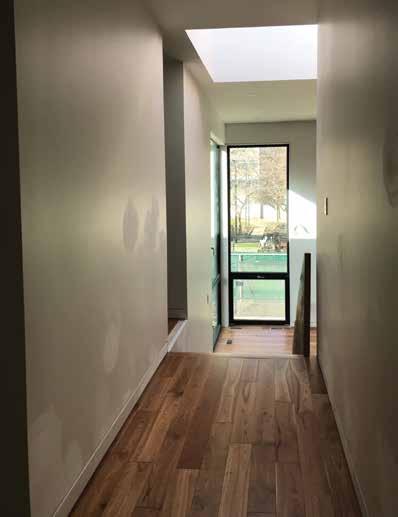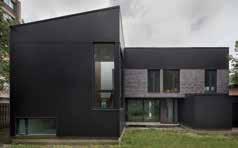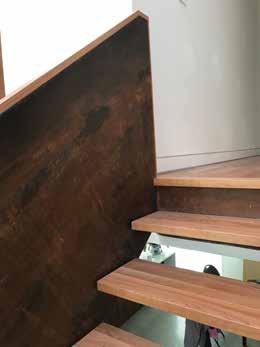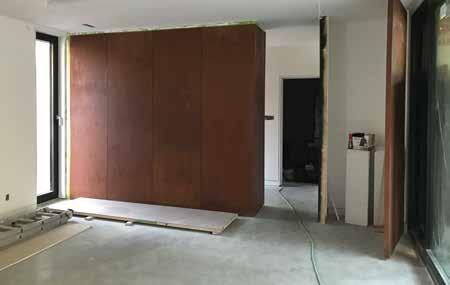
3 minute read
Then-and-Now
Split-level shines after challenging build Rising from the ashes
THE KING EDWARD RESIDENCE is located in the town of Côte Saint-Luc, Que., on the island of Montreal. The home is seated on King-Edward Street where “split-level” typology abounds, typical of 1950s houses when the street was developed.
Keyhole view to the backyard: It is one such residence that stood on this site Atelier Schwimbefore a fire ravaged it. Its owners, a young couple, had mer and the chosen it among several others because it met their homeowners programmatic needs and their preferred layout. wanted to Mandated to replace it, Atelier Schwimmer, a demarcate arMontreal-based design and architectural firm, pro- eas of the house posed a new form rooted both in a reinterpretation of into “adult” and the split-level typology while reconsidering the house “child.” Here, insertion to the lot. cherry floors Design principal Felix Schwimmer, along with provide the pathAtelier Schwimmer associates Georgia Cardosi and way from the Francesca Fiaschi, tackled the challenge of a proper- grown-ups’ main ty that was so destroyed, even the foundation was floor to the kids’ compromised. “Because the fire was in the basement, zone downstairs. the structural engineer decided it was better to just start from scratch. In the 1950s, not every contractor prepared good concrete,” says Schwimmer. The back split orientation has the ground floor as you enter the home for the grown-up spaces Front and rear views of Atelier Schwimmer’s and the base21st century split-level show box components. ment for the children, according to Schwimmer. “In the back we have the half level down, which goes to the family room for kids, and then we have a half level up, which is the family room for the adults.” The concrete slab floors were handled by an expert who has developed a technique that creates “a really nice polish,” says Schwimmer. The process involves smoothing the surface twice when it is wet and three times when dry to provide a matte finish. The concrete floors are also insulated and heated for consistent comfort across the two levels. Upstairs living quarters are wall-to-wall cherry wood chosen be Atelier Schwimmer to provide a warm contrast to all of the concrete. The homeowners chose their own bathroom tiles. The new house is made of rectangular boxes stacked in a way to create a large accommodating backyard, in opposition to the previous house — a cube in the middle of the lot that hindered the side courts and resulted in a small backyard. Viewed from above, those new boxes make a U-shape house shielding from the southern neighbour, a 10-storey “brutalist” style building. The black metal cladded garage box is recessed from the front facade, creating a loggia entrance; it sits perpendicular to the




Above: Pouring the concrete slab. The original foundation was found too unstable for re-use after a devastating fire. Below: Wooden stair treads (left) warm up the transition to the second level sleeping quarters, while heated concrete floors (right) raise the temperature during cold winter nights.

street. The day room box is thinner than the second floor, parallel to the street and open to the backyard. Above the night box overhangs the lower floor and holds the bedrooms. These principal boxes are cladded with ash berry velour brick, forming a “T” shape front facade. Finally, inside the vertical black steel cladded box, a den and a family room sit on split-levels. Inside, steel cladded walls accentuate threshold spaces, which are the entrance and vertical connection in-between floors. As you enter the house, you’re greeted by views toward the backyard; a few steps in the house lets the day room appear, as if the warm orange steel wall protects access. This transition is repeated where the staircase climbs into a vertical void capped by a skylight. Both the structure of the staircase and the wall are made of steel — these central elements endow the residence a grand space with its 30 feet interior wall and void. Schwimmer noted that the owners had very bad luck with contractors during the 18-month construction project, including with the foundation, HVAC and exterior. “It was one thing on top of another,” he said. “They re-did the front brick three times, including once after an acid burned the surface of the brick.” The topper was that six months after moving in, the couple divorced. “Everything was perfectly done in the end,” says Schwimmer. “Sometimes life is unlucky.”






